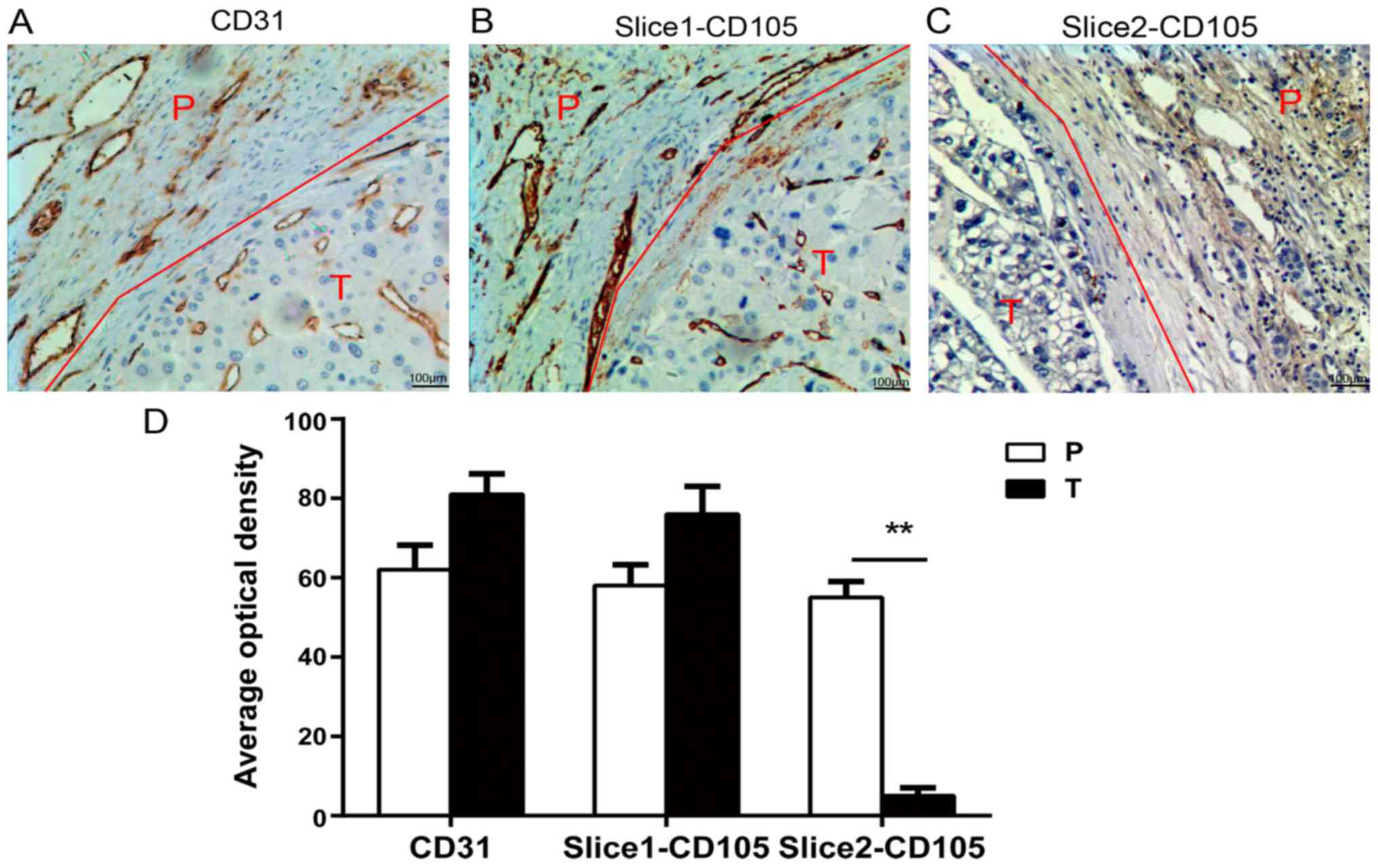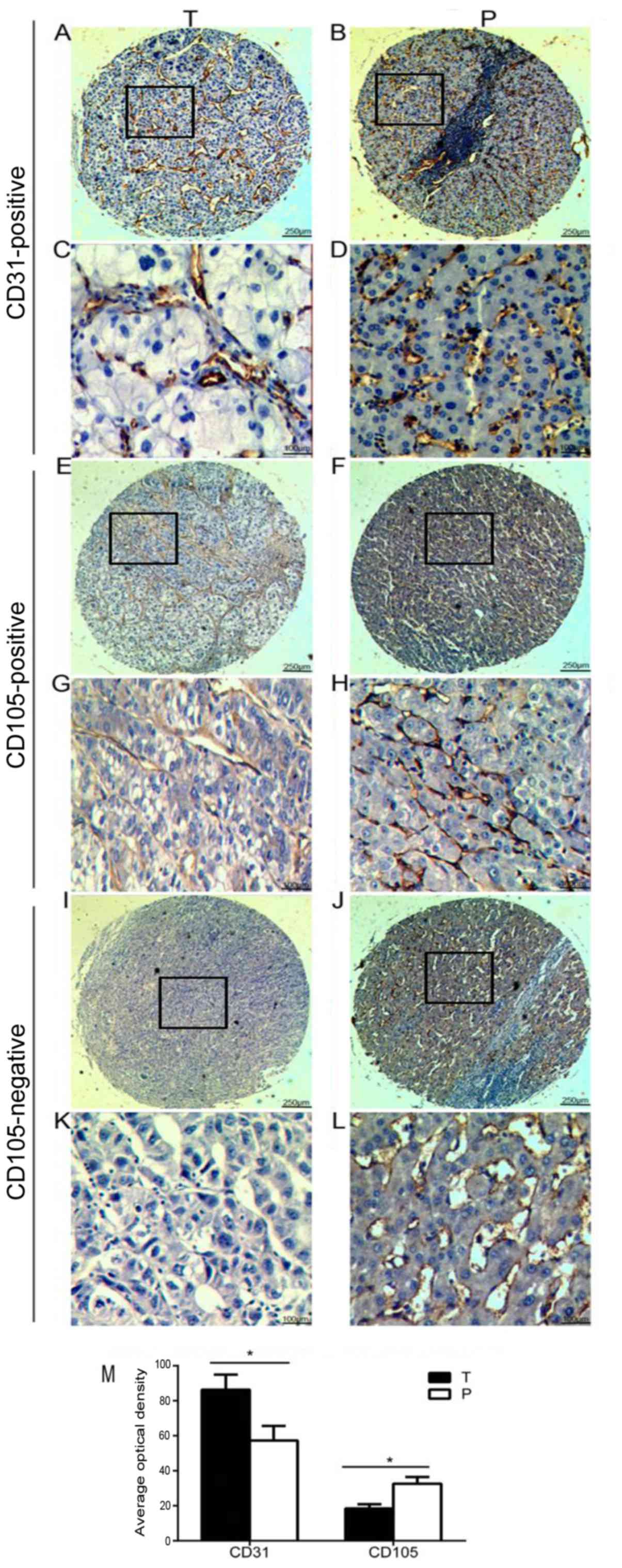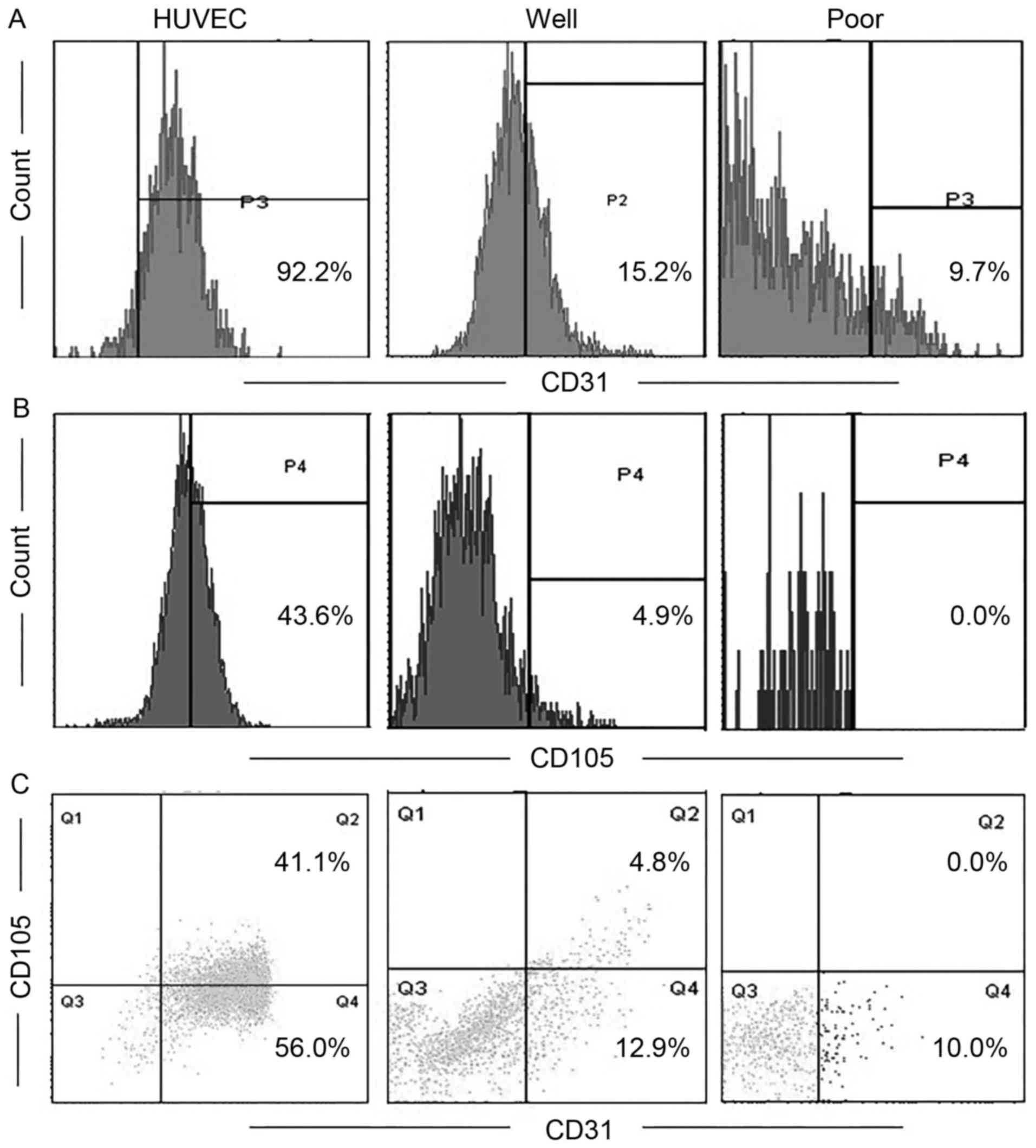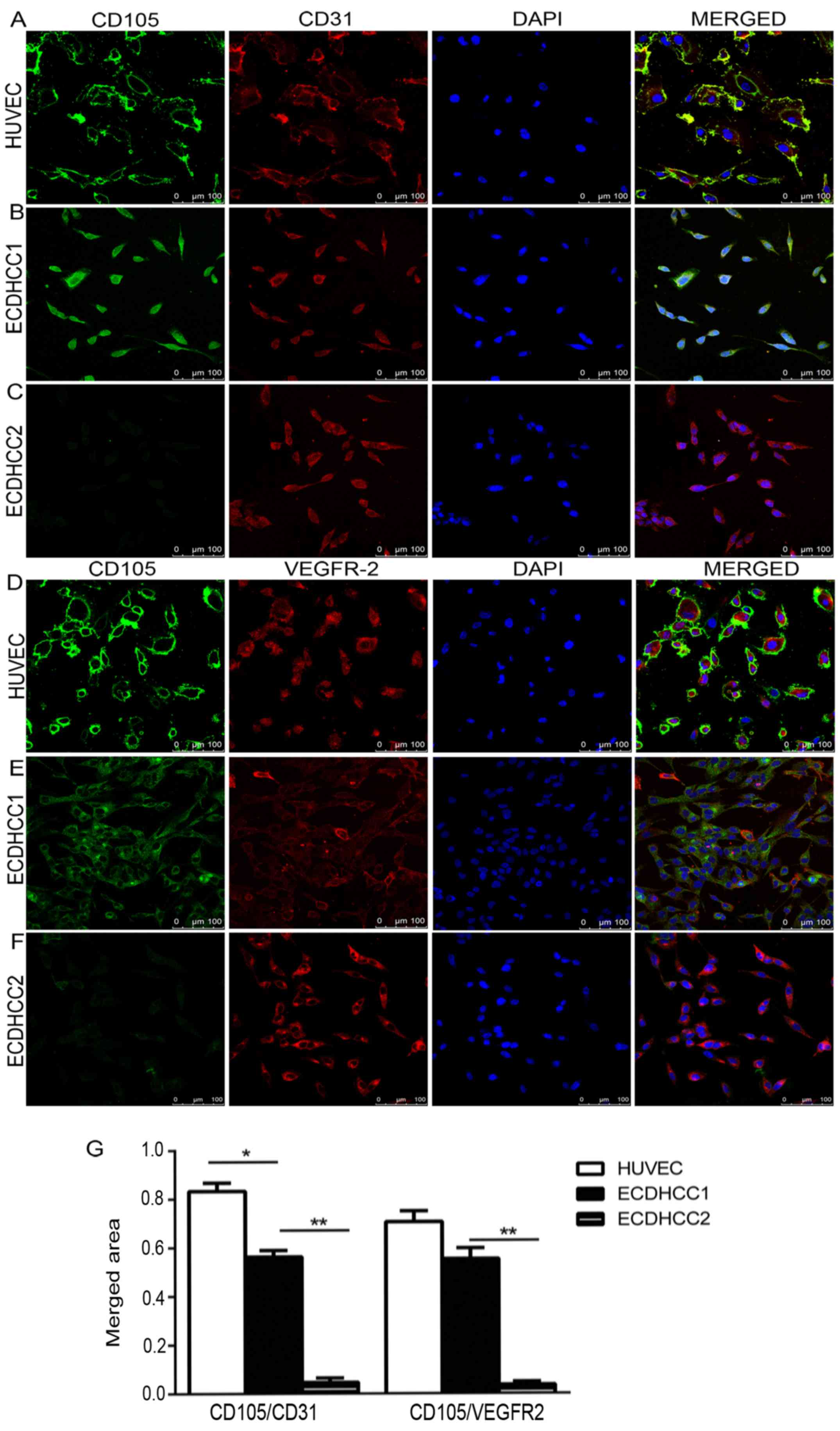|
1
|
Holleb AI and Folkman J: Tumor
angiogenesis. CA Cancer J Clin. 22:226–229. 1972. View Article : Google Scholar : PubMed/NCBI
|
|
2
|
Bian XW, Wang QL, Xiao HL and Wang JM:
Tumor microvascular architecture phenotype (T-MAP) as a new concept
for studies of angiogenesis and oncology. J Neurooncol. 80:211–213.
2006. View Article : Google Scholar : PubMed/NCBI
|
|
3
|
Ohga N, Ishikawa S, Maishi N, Akiyama K,
Hida Y, Kawamoto T, Sadamoto Y, Osawa T, Yamamoto K, Kondoh M, et
al: Heterogeneity of tumor endothelial cells: Comparison between
tumor endothelial cells isolated from high- and low-metastatic
tumors. Am J Pathol. 180:1294–1307. 2012. View Article : Google Scholar : PubMed/NCBI
|
|
4
|
Duff SE, Li C, Garland JM and Kumar S:
CD105 is important for angiogenesis: Evidence and potential
applications. FASEB J. 17:984–992. 2003. View Article : Google Scholar : PubMed/NCBI
|
|
5
|
Mahajan KD, Nabar GM, Xue W, Anghelina M,
Moldovan NI, Chalmers JJ and Winter JO: Mechanotransduction effects
on endothelial cell proliferation via CD31 and VEGFR2: Implications
for immunomagnetic separation. Biotechnol J. 12:2017. View Article : Google Scholar : PubMed/NCBI
|
|
6
|
Qin M, Guan X, Wang H, Zhang Y, Shen B,
Zhang Q, Dai W, Ma Y and Jiang Y: An effective ex vivo approach for
inducing endothelial progenitor cells from umbilical cord blood
CD34+ cells. Stem Cell Res Ther. 8:252017. View Article : Google Scholar : PubMed/NCBI
|
|
7
|
Xiong YQ, Sun HC, Zhang W, Zhu XD, Zhuang
PY, Zhang JB, Wang L, Wu WZ, Qin LX and Tang ZY: Human
hepatocellular carcinoma tumor-derived endothelial cells manifest
increased angiogenesis capability and drug resistance compared with
normal endothelial cells. Clin Cancer Res. 15:4838–4846. 2009.
View Article : Google Scholar : PubMed/NCBI
|
|
8
|
Moghaddam Afshar N, Mahsuni P and Taheri
D: Evaluation of endoglin as an angiogenesis marker in
glioblastoma. Iran J Pathol. 10:89–96. 2015.PubMed/NCBI
|
|
9
|
Davidson B, Stavnes HT, Førsund M, Berner
A and Staff AC: CD105 (Endoglin) expression in breast carcinoma
effusions is a marker of poor survival. Breast. 19:493–498. 2010.
View Article : Google Scholar : PubMed/NCBI
|
|
10
|
Fonsatti E, Nicolay HJ, Altomonte M, Covre
A and Maio M: Targeting cancer vasculature via endoglin/CD105: A
novel antibody-based diagnostic and therapeutic strategy in solid
tumours. Cardiovasc Res. 86:12–19. 2010. View Article : Google Scholar : PubMed/NCBI
|
|
11
|
Sakurai T, Okumura H, Matsumoto M,
Uchikado Y, Owaki T, Kita Y, Setoyama T, Omoto I, Kijima Y,
Ishigami S, et al: Endoglin (CD105) is a useful marker for
evaluating microvessel density and predicting prognosis in
esophageal squamous cell carcinoma. Anticancer Res. 34:3431–3438.
2014.PubMed/NCBI
|
|
12
|
Martinez LM, Labovsky V, Calcagno Mde L,
Davies KM, Rivello HG, Wernicke A, Calvo JC and Chasseing NA:
Comparative prognostic relevance of breast intra-tumoral
microvessel density evaluated by CD105 and CD146: A pilot study of
42 cases. Pathol Res Pract. 212:350–355. 2016. View Article : Google Scholar : PubMed/NCBI
|
|
13
|
Saroufim A, Messai Y, Hasmim M, Rioux N,
Iacovelli R, Verhoest G, Bensalah K, Patard JJ, Albiges L, Azzarone
B, et al: Tumoral CD105 is a novel independent prognostic marker
for prognosis in clear-cell renal cell carcinoma. Br J Cancer.
110:1778–1784. 2014. View Article : Google Scholar : PubMed/NCBI
|
|
14
|
Yao Y, Pan Y, Chen J, Sun X, Qiu Y and
Ding Y: Endoglin (CD105) expression in angiogenesis of primary
hepatocellular carcinomas: Analysis using tissue microarrays and
comparisons with CD34 and VEGF. Ann Clin Lab Sci. 37:39–48.
2007.PubMed/NCBI
|
|
15
|
Chen CH, Chuang HC, Lin YT, Fang FM, Huang
CC, Chen CM, Lu H and Chien CY: Circulating CD105 shows significant
impact in patients of oral cancer and promotes malignancy of cancer
cells via CCL20. Tumour Biol. 37:1995–2005. 2016. View Article : Google Scholar : PubMed/NCBI
|
|
16
|
Nair S, Nayak R, Bhat K, Kotrashetti VS
and Babji D: Immunohistochemical expression of CD105 and TGF-β1 in
oral squamous cell carcinoma and adjacent apparently normal oral
mucosa and its correlation with clinicopathologic features. Appl
Immunohistochem Mol Morphol. 24:35–41. 2016. View Article : Google Scholar : PubMed/NCBI
|
|
17
|
Ho JW, Poon RT, Sun CK, Xue WC and Fan ST:
Clinicopathological and prognostic implications of endoglin (CD105)
expression in hepatocellular carcinoma and its adjacent
non-tumorous liver. World J Gastroenterol. 11:176–181. 2005.
View Article : Google Scholar : PubMed/NCBI
|
|
18
|
Li C, Hampson IN, Hampson L, Kumar P,
Bernabeu C and Kumar S: CD105 antagonizes the inhibitory signaling
of transforming growth factor beta1 on human vascular endothelial
cells. FASEB J. 14:55–64. 2000. View Article : Google Scholar : PubMed/NCBI
|
|
19
|
Li C, Issa R, Kumar P, Hampson IN,
Lopez-Novoa JM, Bernabeu C and Kumar S: CD105 prevents apoptosis in
hypoxic endothelial cells. J Cell Sci. 116:2677–2685. 2003.
View Article : Google Scholar : PubMed/NCBI
|
|
20
|
Hewett PW: Isolation and culture of human
endothelial cells from micro- and macro-vessels. Methods Mol Biol.
1430:61–76. 2016. View Article : Google Scholar : PubMed/NCBI
|
|
21
|
Siegel AB, Cohen EI, Ocean A, Lehrer D,
Goldenberg A, Knox JJ, Chen H, Clark-Garvey S, Weinberg A, Mandeli
J, et al: Phase II trial evaluating the clinical and biologic
effects of bevacizumab in unresectable hepatocellular carcinoma. J
Clin Oncol. 26:2992–2998. 2008. View Article : Google Scholar : PubMed/NCBI
|
|
22
|
Gutierrez M and Giaccone G: Antiangiogenic
therapy in nonsmall cell lung cancer. Curr Opin Oncol. 20:176–182.
2008. View Article : Google Scholar : PubMed/NCBI
|
|
23
|
Ricci-Vitiani L, Pallini R, Biffoni M,
Todaro M, Invernici G, Cenci T, Maira G, Parati EA, Stassi G,
Larocca LM, et al: Tumour vascularization via endothelial
differentiation of glioblastoma stem-like cells. Nature.
468:824–828. 2010. View Article : Google Scholar : PubMed/NCBI
|
|
24
|
Wang R, Chadalavada K, Wilshire J, Kowalik
U, Hovinga KE, Geber A, Fligelman B, Leversha M, Brennan C and
Tabar V: Glioblastoma stem-like cells give rise to tumour
endothelium. Nature. 468:829–833. 2010. View Article : Google Scholar : PubMed/NCBI
|
|
25
|
Lyden D, Hattori K, Dias S, Costa C,
Blaikie P, Butros L, Chadburn A, Heissig B, Marks W, Witte L, et
al: Impaired recruitment of bone-marrow-derived endothelial and
hematopoietic precursor cells blocks tumor angiogenesis and growth.
Nat Med. 7:1194–1201. 2001. View Article : Google Scholar : PubMed/NCBI
|
|
26
|
Castilho-Fernandes A, de Almeida DC,
Fontes AM, Melo FU, Picanço-Castro V, Freitas MC, Orellana MD,
Palma PV, Hackett PB, Friedman SL, et al: Human hepatic stellate
cell line (LX-2) exhibits characteristics of bone marrow-derived
mesenchymal stem cells. Exp Mol Pathol. 91:664–672. 2011.
View Article : Google Scholar : PubMed/NCBI
|
|
27
|
Rubatt JM, Darcy KM, Hutson A, Bean SM,
Havrilesky LJ, Grace LA, Berchuck A and Secord AA: Independent
prognostic relevance of microvessel density in advanced epithelial
ovarian cancer and associations between CD31, CD105, p53 status,
and angiogenic marker expression: A Gynecologic Oncology Group
study. Gynecol Oncol. 112:469–474. 2009. View Article : Google Scholar : PubMed/NCBI
|
|
28
|
Miyata Y, Mitsunari K, Asai A, Takehara K,
Mochizuki Y and Sakai H: Pathological significance and prognostic
role of microvessel density, evaluated using CD31, CD34, and CD105
in prostate cancer patients after radical prostatectomy with
neoadjuvant therapy. Prostate. 75:84–91. 2015. View Article : Google Scholar : PubMed/NCBI
|
|
29
|
Yang L, Bryder D, Adolfsson J, Nygren J,
Månsson R, Sigvardsson M and Jacobsen SE: Identification of
Lin(−)Sca1(+)kit(+)CD34(+)Flt3-short-term hematopoietic stem cells
capable of rapidly reconstituting and rescuing myeloablated
transplant recipients. Blood. 105:2717–2723. 2005. View Article : Google Scholar : PubMed/NCBI
|
|
30
|
Zhou Y, Gu H, Xu Y, Li F, Kuang S, Wang Z,
Zhou X, Ma H, Li P, Zheng Y, et al: Targeted antiangiogenesis gene
therapy using targeted cationic microbubbles conjugated with CD105
antibody compared with untargeted cationic and neutral
microbubbles. Theranostics. 5:399–417. 2015. View Article : Google Scholar : PubMed/NCBI
|
|
31
|
Li Y, Zhai Z, Liu D, Zhong X, Meng X, Yang
Q, Liu J and Li H: CD105 promotes hepatocarcinoma cell invasion and
metastasis through VEGF. Tumour Biol. 36:737–745. 2015. View Article : Google Scholar : PubMed/NCBI
|














